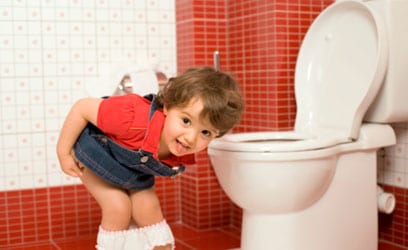The first step in determining an approach to potty training is looking for signs of readiness in your toddler. Most toddlers will show readiness for potty training between the ages of 2 and 3 years. Look for clues in body language, such as squatting or tugging at the diaper; word use, such as potty or poo poo; cognitive cues, such as understanding that the diaper is wet; social cues, such as the toddler talking about big boys and girls who use the potty; behavioral signs, such as responding to praise; and modeling signs, such as imitating parents or older siblings.
Frequency Method
The frequency method is often adopted as a potty training boot camp measure, with adults taking the toddler to the bathroom several times per day to avoid accidents. This approach demands consistency and patience, because accidents will still happen. Parents sometimes combine this approach with a reward system.
Dr. Phil Method
Dr. Phil McGraw developed a method for potty training that he insists requires just 1 day to implement. He recommends giving the toddler a doll that wets and dressing the toddler in underwear, not pull-up diapers. Give both the child and the doll plenty of fluids. Ask the toddler to accompany you and the doll to the bathroom. Remove the doll’s underwear and place the doll on the potty chair. Right after the doll successfully uses the potty, throw a celebration for it with decorations, hats, balloons and more fluids. Tell the toddler there will be another party when she uses the potty. Ask her if she would like to use the potty. Continue this cycle until the toddler uses the potty. Once she is successful, throw a celebration. If the child has an accident, refrain from punishing her or becoming negative or emotional. Calmly take her to the potty and practice using it.
Naked Approach
With the super-absorbent diapers on the market, sometimes having your toddler potty train in the nude is the best way for him to realize what is happening when he uses the bathroom. This potty training technique can be messy, so prepare the house by covering any upholstered furniture. Point out the potty seat to the toddler. When she starts to urinate, react calmly and point out the potty seat to her. The negative reinforcement of wetting herself is often enough motivation for a toddler to use the potty.
Reward System
The reward system for potty training can be used to complement other techniques. Have your toddler help you create a chart to place near the potty seat. Every time he uses the potty successfully, either with parental prompting or his own, place a sticker or draw a star on the chart. Remind the toddler about the chart and its purpose every time he uses the potty seat or has an accident. After a certain number of stickers, allow the toddler to cash them in for a prize. Some toddlers require more immediate positive reinforcements, such as a few small pieces of candy. Other toddlers only require praise as their positive reinforcement.
Training Pants
Disposable training pants have made potty training a less messy endeavor. However, many child development experts argue that these absorbent pants can actually delay potty training. The bulk, wetness and discomfort of a soiled diaper can be concrete signals that teach a toddler what happens when they go in their diapers instead of on the potty. Toddlers who are particularly motivated to use the potty seat or who desire underpants before they are really ready for them benefit most from training pants.





